Images of “Inqlab 57” that were published for the first time/spontaneous recording of moments – Mehr News Agency | Iran and world’s news

According to Mehr reporter, the documentary on the reconstruction of “Days of the Revolution” directed by Hamed Kazemzadeh is produced by the History, Culture and Art Group of One Sima channel, which is broadcast every night at 20:00 on One Sima channel during the dawn of the Islamic revolution.
Hamed Kazemzadeh, the producer and director of this documentary, referring to the initial idea of this work, told Mehr reporter: Video And we had found photos of people that had never been published anywhere; Young people who voluntarily and spontaneously took action with their photography and video cameras to record the moments of the 1957 revolution. Of course, among these subjects, there were also people who took pictures with professional cameras.
He added: What was of primary importance and priority for us and we paid attention to it in the production of this program was the presence of the youth of the 50s. Young people who spontaneously went to the streets to capture moments without being photographers.
This television director pointed out that the films of these people had not been shown anywhere, and continued: We are absolutely sure that none of these images have been published in any media before; Because these films had not been published before us.
The director of “Days of the Revolution” said: When we first encountered this subject, we had a list of people who had pictures of the events leading up to the 1957 revolution. This list included a large number of people. When contacting these people, other friends and companions were also introduced to us.
He continued: Finding these subjects was a difficult task, we had to choose from among 160 people. Some of these people were unable to participate in the program due to their old age, some had passed away, and some did not wish to participate. Nevertheless, based on several cases, subjects were selected to reach the final 10 people.
This TV producer and director explained: It was important for us that the characters were visually appealing. The stories and images they have recorded should have a good dramatic meaning and they should record important events from a historical point of view.
Referring to the pre-production process, Kazemzadeh said: We started the pre-production work from the end of August and the beginning of September, and from January we continued the production stages of various parts simultaneously with the pre-production process.
He added: The work was produced in 3 parts. The first part was done by preparing a location as a documentary maker’s office in the studio. By preparing a studio, we invited the subjects to define their memory. In the second part, we went to their homes and workplaces to get to know their current situation. The third part was the reconstruction of the lives of these loved ones, and the images they recorded themselves are used in the work as archival images.
The producer and director of “Days of Revolution” stated that the compilation of this reconstruction documentary is still ongoing, and explained: “It is very difficult to approach these subjects with the intention of producing a different work.” Especially in the short time we had. We tried our best to offer something new in this field. For this reason, we approached the subjects from a different perspective.
He added: “Instead of photos and videos, we went to the hardships and hardships that photographers and videographers had during that period of time to prepare cameras, record images, and how they appeared and printed.” In fact, more than the films and photos prepared, the way of photography was considered at one point in time, the 1957 revolution.
The director of the remake of “Days of the Revolution” documentary said: Each episode of this program is related to a different subject. For example, we have the story of 17 Shahrivar in most of the episodes, but this event has been covered in different cities and recorded from different angles. Along with the presence of photographers and videographers, we tried to take advantage of the eyewitnesses who were present in that event to look at this story from another angle.
Kazemzadeh explained: The reconstruction part was very important for us in terms of visual and content. For this reason, we tried to select the actors of this section with the utmost care in the short time we had According to There is an apparent similarity. Much of the work involved reconstruction of events. We tried to do this part well considering the financial limitations and the time available to produce the work. Definitely, the power of documentary programs is not so much that it is possible to reconstruct historical events in detail, but they try Mann It was to make the reconstructions realistic and based on details.
In the end, Kazemzadeh said: We thought that none of these 10 produced episodes would be similar in terms of content and visuals. In fact, we looked at the same event from different angles and portrayed the views of different people about the events.

